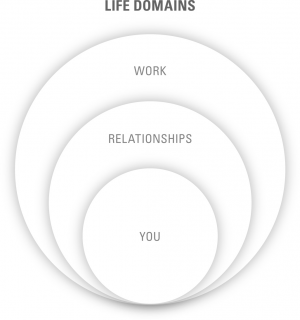
I like growing things.
As a gardener, I feel there are also a number of lessons that one learns horticulturally in helping plants to grow and flourish that can be carried over into my work as a psychotherapist. One of these is that even the best intentions in the world, certain plants need very specific growing conditions and forms of assistance in order to flourish and become the “best” versions of themselves.
By flourishing, I mean: growing strong and resilient, as well as flowering (i.e. “enjoying” and finding meaning in one’s life) to the best of our abilities. Some seeds will only germinate when their environmental temperature and humidity are stable within certain parameters. Some plants need a lot of water and nutrients to flourish, others need much less. If this undoubtedly true for such simple life forms, as well as every other non-human life creature, why should it be significantly different for us?
The LIFE MOT is one way in which to assess whether your life and the way you have set it up is well-geared to producing the kind of flourishing (we sometimes call this “happiness” or “well-being”) that you would like to experience as a human being. It is also one of the four factors that I consider to be an essential component of any therapeutic journey, even if one doesn’t do it in a formal way as I’ve laid out below.
The intention of The Life MOT is not to find fault with, or make drastic changes to how you’ve set up your “growing environment”, as often our life-circumstances, as well as our relatively-hardwired personalities won’t allow for this, but more to see if there’s any way we can tweak some of the environmental, behavioral, and in the case of humans psychological components of our lives (how we engage with the world in our own minds), in order to give ourselves the best chance at flourishing, even if just by 10% or 20% more than we’re currently doing.
THE LIFE-MOT AND TRAUMA
 Another reason for doing a LIFE MOT is the presence of trauma in our lives, and the recognition of how that (at times) both hinders as well as ultimately may benefit us.
Another reason for doing a LIFE MOT is the presence of trauma in our lives, and the recognition of how that (at times) both hinders as well as ultimately may benefit us.
In the last decade there has been a great deal of research and writing on something which we now call post-traumatic growth, pointing out ways in which we can, if we choose, use our traumas to sharpen our life instincts, creating enriched ways of living and being through and with the residual pain of those inner thorns.
We’re not just talking about the big capital-T traumas here such as a life-threatening illness or abuse, but also about everyday traumas, the kind that pull the rug out from under us: a divorce, losing a loved one, sickness, surgery, an accident, or even the misattunement and lack of emotional responsiveness that many of us feel we didn’t get from our childhood caregivers (our parents, teachers, and other family members). Trauma lies in the heart of the beholder. We never know what etches itself indelibly into our hearts.
According to psychologist Richard Tedeschi, post-traumatic growth’s leading researcher, as many as ninety percent of survivors report at least one aspect of post-traumatic growth, such as a renewed appreciation for life or a deeper connection to their heart’s purpose, which is to say their core values and how these are expressed in day-t0-day actions and self-talk.
But this does not happen immediately or easily, and not always by itself. We often need to actively work towards this kind of change, and in doing so, we need the right tools and support in order to transform our trauma into the life we might desire for our ourselves (some version of rich, fulfilling, and meaningful, even if painful at times too).
Tedeschi didn’t just create a theory and then try to prove it with studies however; it was rather the other way around.He and his team were consulting with trauma survivors, initially bereaved parents, then people who had lost the loves of their lives, or were severely injured, cancer survivors, veterans, and prisoners, when he noticed something that united most of the people he talked to. Again and again, traumatised individuals shared a perplexing insight: while they were not happy about what had happened to them, they felt they had learned valuable lessons from the experience, and these lessons eventually changed their lives for the better. Which is to say, partly due to having suffered themselves in various ways, they became better parents, better partners, and more compassionate friends; many also discovered, or re-discovered a new purpose in life. As Leonard Cohen would say: “There is a crack, a crack in everything: that’s how the light gets in.”
Psychologist Stephen Joseph is not the only one to regard this phenomenon of post-traumatic growth as “one of the most exciting of all the recent advances in clinical psychology, because it promises to radically alter our ideas about trauma—especially the notion that trauma inevitably leads to a damaged and dysfunctional life.”
The LIFE MOT might be seen as the first stage (the assessment and life-reckoning stage) of what I see as a three-part process:
- Assessing how we are living our lives, where we are putting our time and energy, understanding to what extent we are (or are not) getting the most out of the lives we’ve been given.
- Clarifying our core values: who we want to be, how we want to act towards others, and even more importantly ourselves, and seeing in what ways this already maps onto our lifestyle (where we put our time and energy). This also usually involves recognising those activities/people/projects/thought-processes we might want to put more of our time and energy into, and which less.
- Working together with me to structure and engineer this. This is the trickiest part as our minds are energy-conserving, and habit-led entities that don’t respond well to change, even the smallest of changes. The third part of the LIFE MOT needs to be a very gentle, self-compassionate, and gradual process. If it is rushed, it generally founders.
HOW TO GET THIS PROCESS GOING?
There are two effective and simple ways to get this process going. The first I’m going to present to you below, and the second over here. I would suggest having a quick look at both of these methods, as you may prefer to do one before the other, although I think both measures are often useful to think about in tandem.
Let’s call the first method THE HAPPINESS/WELL-BEING LENS. This, as the name suggests has well-being as its central focus.
The second method, which I call THE THREE DIMENSIONS OF VALUE is more connected to the meaning and significance of our lives.
THE HAPPINESS/WELL-BEING LENS
 So here’s how you would go about applying a happiness/well-being lens to the life you’re living at the moment.
So here’s how you would go about applying a happiness/well-being lens to the life you’re living at the moment.
Think about all the stuff you do in your three life domains (you, work, relationships).
Imagine you had a camera crew following you around 24/7 for a documentary, and that you now have this footage of yourself and have been asked to index all of your LIFE ACTIVITIES, in as precise detail as possible spreading them among your three domains. Make sure you also list all your INNER activities (the kinds of thoughts and dialogues you have with yourself in the privacy of your own mind) as well as the OUTER ones.
Begin by grouping your LIFE ACTIVITIES list into a few different categories. Maybe the following:
- THINGS I DO THAT CONTRIBUTE IN AN ESSENTIAL WAY TO MY WELL-BEING (PHYSICAL & MENTAL)
- THING I DO THAT CONTRIBUTE IN AN IMPORTANT/NECESSARY WAY TO MY WELL-BEING (PHYSICAL & MENTAL)
- THINGS I DO THAT ARE NOT GOOD FOR MY WELL-BEING (PHYSICAL & MENTAL)
- THINGS I DO THAT DON’T FIT INTO THE OTHER THREE CATEGORIES (I.E. NOT SURE OF EFFECT ON MY WELL-BEING
Here’s an example (a mixture of my own activities list as well as family members who I tried this out on when I was first experimenting with the concept) to give you a flavour of some of the things you might want to include in your list: https://docs.google.com/document/d/1w-BGJP9GiaP_55A_gsjNUNJDFAH2JaQuZGYVQUNRPaI/edit?usp=sharing
Great. You are now ready to think a little about meaning and significance in your life via THE THREE DIMENSIONS OF VALUE, or move to the conversation part of this process, Stage 2, which is best done as a conversation with me in one of our sessions 🙂
When you are undertaking this preparatory stage, try and keep your Inner-Critic at bay! He 0r she will no doubt have much to say (in a haranguing, even unkind way) about all those things you do that are not especially good for your well-being (physical, or mental, or both). I would suggest you say to your Inner-Critic at this stage: “Please let me just get on with this without the commentary. EVERYONE is a mish-mash of doing things good/not-s0-good/injurious to themselves, and I am no different. The point of this exercise is not to have you beat me up and feel bad about myself for all the things I could be doing more of, less of, or better. It is an exercise in curiosity, and taking stock, that’s all. So please give me a break.”
